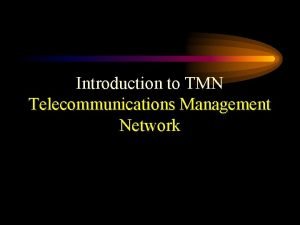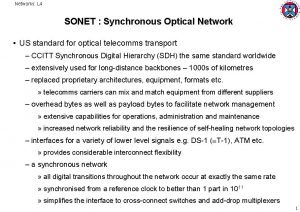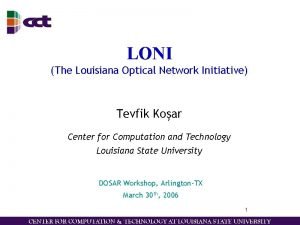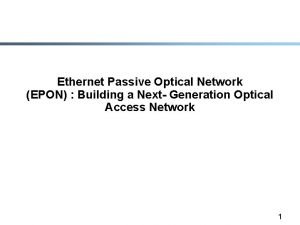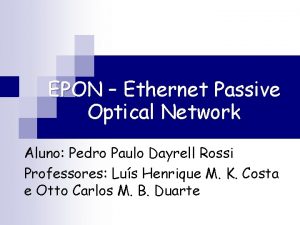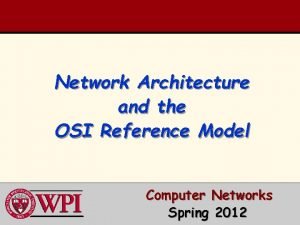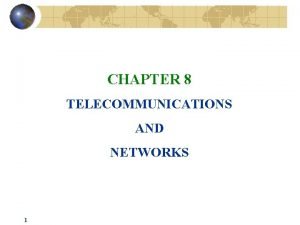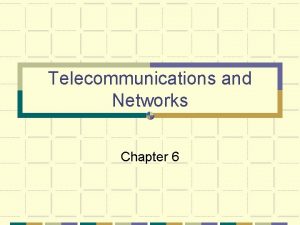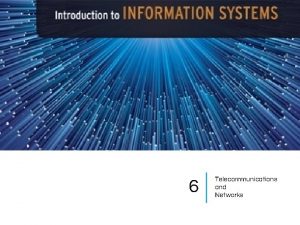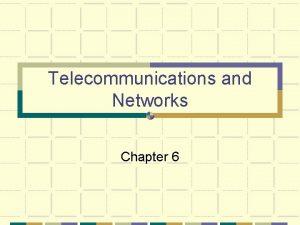Introduction to Optical Networks 1 Telecommunications Network Architecture
















- Slides: 16

Introduction to Optical Networks 1

Telecommunications Network Architecture 2

Telecommunications Network Architecture • Metro network: lie within a city or a region – Access network: extend from a central office to businesses and homes – Interoffice network: connect central offices within a city or a region • Long-haul network: interconnect cities or regions 3

Desired Features of Telecommunications Networks • High capacity • Efficiently support data traffic – Use packet switching • Deliver new and flexible types of services – Bandwidth on demand – Restorable connections with different restoration guarantees 4

Optical Networks • Optical fibers as transmission media – High bandwidth: tens of Tbps – Low loss and low bit error rate • Two ways to increase the transmission capacity on a fiber: – Increase the bit rate with time division multiplexing (TDM): many lower speed data streams are multiplexed into a higher-speed stream – Wavelength division multiplexing (WDM): transmit data simultaneously at multiple wavelengths • TDM and WDM combined: tens of Tbps 5

Optical Networks • Two generations – First generation: switching and processing done by electronics • SONET – Second generation: routing and switching done in optical domain • Wavelength routing networks 6

Synchronous Optical Network (SONET) • The ANSI standard for synchronous data transmission on optical media. • Provide end-to-end circuit-switched connections • Provide efficient mechanism for multiplexing low-speed connections into higher-speed connections – Define a base rate of 51. 84 Mbps and a set of multiples of the base rate known as "Optical Carrier levels (OCx)" • Provide efficient way to extract low-speed streams from a high-speed stream at intermediate nodes • High availability (99. 99% to 99. 999%) – Rapid service restoration in the event of failures 7

SONET Transmission Rates OC-1 = 51. 84 Mbps OC-3 = 155. 52 Mbps OC-12 = 622. 08 Mbps OC-24 = 1. 244 Gbps OC-48 = 2. 488 Gbps OC-192 = 9. 953 Gbps OC-768 = 39. 814 Gbps 8

SONET Elements • Terminal multiplexers (TMs): nodes at the ends of point-to-point links, multiplex and demultiplex traffic streams • Add/drop multiplexers (ADMs): drop/add one or more low-speed streams from/to a high-speed stream, allow the remaining traffic to pass through – Deployed in linear and ring networks • Digital crossconnects (DCSs): large number of ports, extract and switch lower-speed streams (44. 736 Mbps and 1. 544 Mbps), interconnect SONET rings 9

Wavelength Routing Networks • Optical layer provides lightpath services to client layers (e. g. IP, ATM, SONET) • Lightpath: a circuit switched connection between two nodes set up by assigning a dedicated wavelength on each link in its path – All links in the path must be assigned the same wavelength if network nodes are not capable of wavelength conversion – Wavelength conversion can reduce connection blocking 10

Lightpath Service • Transparent to bit rate and protocol format • Advantages – Service transparency: can provide different services using a single infrastructure – Future-proof: allow new services to be deployed rapidly 11

Network Elements • Optical line terminals (OLTs): – multiplex multiple wavelengths into a single fiber – demultiplex wavelengths on a single fiber into separate wavelengths • Optical add/drop multiplexers (OADMs): – drop/add one or more wavelengths from/to a composite WDM signal, allow the remaining wavelengths to pass through – two line ports and a number of local ports • Optical crossconnects (OXCs): – switch wavelengths from one port to another – large number of ports 12

13

Advantages of Wavelength Routing • Reduce costs (switch ports, electronic processing) at the client layer by routing pass-through traffic in the optical layer • Support different traffic patterns 14

Future Services • Packet switched virtual circuit service – Connection bandwidth can be smaller than the full bandwidth on a wavelength • Datagram service: transmit packets without setting up connections 15

Optical Packet Switching • Not feasible at present due to – Lack of optical buffers – Limited processing capabilities in the optical domain – Primitive stage of fast optical-switching technology 16
 Telecommunications network architecture
Telecommunications network architecture Telecommunication processors
Telecommunication processors Tmn physical architecture
Tmn physical architecture Lab127.karelia.ru alexmou
Lab127.karelia.ru alexmou Virtual circuit and datagram
Virtual circuit and datagram Basestore iptv
Basestore iptv Optical correction in greek architecture
Optical correction in greek architecture Synchronous optical network (sonet)
Synchronous optical network (sonet) Louisiana optical network initiative
Louisiana optical network initiative Gigabit ethernet passive optical network
Gigabit ethernet passive optical network Gigabit ethernet passive optical network
Gigabit ethernet passive optical network Optical network evolution
Optical network evolution Optical mesh network
Optical mesh network Single node architecture in wireless sensor networks
Single node architecture in wireless sensor networks Bluetooth in computer networks
Bluetooth in computer networks Architecture osi
Architecture osi Palo alto networks certified network security consultant
Palo alto networks certified network security consultant


